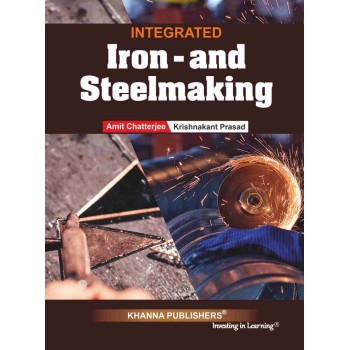Integrated Iron and Steel Making
- Author Amit Chaterjee;Krishnakant Prasad
- ISBN: 978-9392-549-373
-
₹ 279.00
| Book Detail | |
| About The Author's | Dr. Amit Chatterjee Consultant, the Adviser to the MD, Tata Steel Ltd., India. He is a gradunte in Metallurgical Engineering from Banaras Hindu University, Indin. He then obtained his Ph.D, and D.I.C. (Met) Degrees from the well-known Imperial College of Science and Technology. London and worked for two years in Thyssen, Germany, before joining Tata Steel in 1972. Dr. Chatterjee was awarded the Doctor of Science (Engg.), by the University of London in 1988 for his outstanding work on coal-based direct reduction and oxygen steelmaking. His host of honours include the National Metallurgist Award in 1977 by the Ministry of Steel, Govt. of India for outstanding contribution to the production of iron and steel in Indin. Tata Gold Medal for 1997 by the Indian Institute of Metals, India for outstanding contributions to technology management and research and development in the Indian steel industry; Distinguished Metallurgist Award for the year 2000 by The Institution of Engineers (India). He also has many other Awards to his credit. He has been referred to as "The King of Direct Reduction". He has over 550 publications to his credit and is also the author of several books on iron and steel. He is considered to be an international authority in the area of iron and steel. particularly as far as technology selection and adoption is concerned. |
| Category | Metallurgy |
| What's special / Useful in this book | No wonder it is not possible to do full justice to these technologies in a single write up and no attempt has been made to make the present exercise a comprehensive one. Instead we have attempted to give an overview, just to give an idea of the enormity of number and complexities of the technologies employed and, thereby also give an idea of the steps required in attempting to build an enterprise of this type. We, as students in the mid 1960's, had failed to get the complete picture of integrated steel plants by reading books. |
| Edition | 1st |
| Pages | 238 |
| Preface(continue) | In the introductory chapter of this book, we have indicated the history of evolution of Integrated Iron-and Steel Making and in what steps these complexities developed. We have presented the various operating steps and arranged the chapters likewise, roughly following the flow of materials, indicating the technologies involved in these steps. We have emphasised the importance of maintenance, automation and the impact on environment due to the process steps and the ways to minimise it. Towards the end, we have tried to crystal-gaze and have tried to describe what a steel plant of twenty second century would look like. |
| Preface | |
| Preface | Steel, the key material for economic development. is made available in bulk quantities by large Integrated Steelworks. Making it in bulk quantities is one way of making it available at affordable prices. Those who make it in smaller quantities keep themselves viable by limitins theit inputs, process parameters, outputs, etc. thus catering to a very narrow segment of market and also they do not have Aexibility in their inputs. Forward and backward integration employed in an integrated steelworks help them in developing flexibility in all aspects without compromising in profitability. But integration of operations brings with it much higher complexities requiring a large number of complex and intricate technologies. It also requires higher levels of managerial and management skills, which we are not attempting to deseribe in this book. Thus the aspects of Financial Management, Production Management (including Production Planning and Scheduling). Operations Management, Marketing management, etc have not been covered here and we are limiting ourselves to the description of technologies and techniques required in operation. These, in themselves, are massive in number and we have attempted to give only an overview of the more important ones. And the number and complexities of technologies keep increasing day by day. By the name Integrated Steelworks' we meant, not many years ago, a coke oven-blast furnace- basic open hearth furnace-_ingot casting- soaking pit and rolling mill complex. It changed to a coke oven- blast furnace -basic oxygen furnace continuous casting soaking furnaces and rolling mill complex. |
| Table of Contents | |
| Table of Contents | 1. The Journey to integrated iron and Steel Works 2.Ironmaking Processes and Their Inputs 3.Steelmaking: Must Go Green! 4.Casting: Conserving Energy and Increasing Yield 5.Reheating and Shaping: Readying for Customers 6.Pickling and Cold Rolling: Get the Metallic Shine 7.Steel Products: Keep on Counting 8.Refractories: The Holder 9.Maintenance: What Magic it can Bring About 10.Automation in Steel Plants: Pressing the Pedal Down 11.Environmental Aspects: Must Save Our Habitat 12.Future of Ironmaking and Steelmaking: Crystal Ball Gazing |

